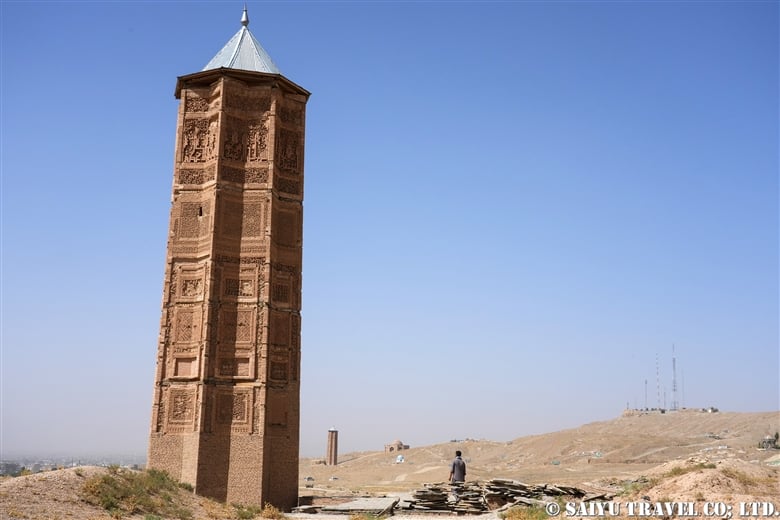
One of the two World Heritage Sites in Afghanistan, Jam minaret and archaeological remains of Jam in the mountains of Ghor Province, the site is not easily accessible neither from Bamiyan nor Herat, and can only be reached by a long drive on rough roads.
It is called a “minaret and archaeological site,” but it is unclear if it is actually a minaret. There is no mosque (perhaps there was an open-type mosque), and there are many opinions, including that it may be a victory tower built over a pre-Islamic pagan holy site.
It could well be Firozkoh of the legendary city, according to one of hypothesis.
There were three main capitals in Ghurid dynasty, Ghazni, Bamiyan, and Firozkoh. The location of one of those three, Firozkoh, is not known, and it is speculated that the ruins near the minaret may be the site of that capital. Incidentally, Chaghcharan in Ghor Province has recently changed its name to Firozkoh and has become a gateway town for tourists visiting the Minaret of Jam from the Bamiyan side.

The Minaret of Jam was built during the reign of the Ghurid dynasty that ruled from Afghanistan to northwestern India, reaching the peak of its power from 1150 to 1215 and reached its peak during the reign of the 12th century king, Ghiyath al-Din Muhammad (1162-1203) and his brother Mu’ izz ad-Din Muhammad (1203-1206). The dynasty was divided after the death of these brothers, and the capital was destroyed by Genghis Khan’s army in 1221. In 1943, the governor of Herat publicized the site, and finally in 1957, the Afghan Historical Society and the French Archaeological Delegation in Afghanistan visited and “discovered” this valuable site.

The site is located at the confluence of two rivers, Harirud and Jam, which has eroded the foundation and tilted the slim tower slightly. The Minaret of Jam is the only remaining structure from the Ghurid dynasty and is very important for understanding Islamic architecture in the medieval period. It was registered as a World Heritage Site (Heritage in Crisis) in 2002.
The Minaret of Jam has three levels, each level separated by a balcony corbel and topped by a circular arcade of six arches.

The first tier up to around 37m is elaborately decorated with molded buff-colored brick reliefs.

The octagonal base of the minaret is 14.5 meters in diameter and 65 meters high, with a tapered tower made of baked bricks. The eight vertical panels corresponding to the octagonal base are superbly done with molded bricks. The rich variety of geometric and plant patterns developed in Bukhara. The most amazing feature is the Arabic Kufi script, in which the entire inscription band of the 19th sura of the Koran (or Qur’an, the holy scripture of Islam), the chapter of Maryam, is represented from one panel to another.

Kufi Arabic, a manifestation of the 19th chapter of the Koran, surrounds the panel and goes on and on and on.Just below the first balcony is a bright Persian blue kufi inscription, the only colored inscription on the surface, declaring the names of the rulers who spearheaded the construction of this minaret. “Ghiyasuddin Mahammad ibn Sam, Sultan Magnificent! King of Kings!” The architect’s name is also inscribed in small letters: “Ali, son of…”.

The Qutub Minar in Delhi, India, is the world’s tallest minaret (72.5 m) made of bricks, built around 1200 during the Delhi Sultanate, whose founder, Quṭb al-Dīn Aybak, served the Ghurid dynasty. The minaret of Qutub Minar was built under the influence of the minaret of Jam. Conversely, there is a “Ghazni minaret” in Ghazni of Ghazna Dynasty, and the Minaret of Jam was constructed under the influence of this minaret.


It used to be possible to climb the spiral staircase inside the minaret, but the entrance is now closed, no longer inaccessible.The view of the “Minaret of Jam” at the end of a long and rough journey is breathtaking and full of archeological awe and majectic beauty.
Image & Text : Mariko SAWADA
Reference :”An historical guide to Afghanistan ” Nancy Hatch Dupree
*Contact us, Indus Caravan for more information or to make arrangements for visiting Minaret of Jam and Afghanistan.
*Please follow us on Youtube, Instagram & Facebook
Category : ◆Afghanistan > - West AfghanistanTag : Minar-e-Jam , Herat , Afghanitan travel , Bamiyan , Tour operator in Afghanistan , Travel company in Afghanistan , Afghanistan , Qutub Minar , Afghanistan tour , Ghazni minaret , Firozkoh , Minaret of Jam , Chaghcharan , World Heritage in Afghanistan , Unesco World Heritage Afghanistan






